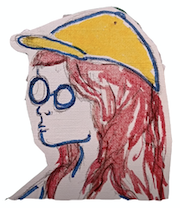-
Formative & Summative Assessment
Through the use of daily warm up questions, I actively engage my students in critical thinking that pertains in some way to an artist, concept, or technique we are exploring in a given lesson. Other methods of formative assessment strategies I employ include “think, pair, share” exercises as well as a daily “exit circle,” in which students share their thoughts on a relevant query before exiting class.
At the end of each lesson, students participate in a final group discussion or “Artist Share” critique. In which, students take turns sharing a bit about their work and call on students for compliments or wishes. This summative exercise is an opportunity to give students a platform to communicate their intentions behind their work, identify areas they would improve, and work together to practice giving respectful, specific, and productive feedback to their peers.

-
Student Authored Rubrics
Following the initial delivery of inspiration content including artist and/or era that will scaffold a lesson, I provide my students the opportunity to author their own rubrics. By doing so, students practice ownership over their own education by identifying their own standards of what they will be graded on. This also provides the freedom students deserve in the art room to nurture their creative voice, allowing the wants and needs of the students to be the guiding force of the artwork.
Group rubric writing also instills the valuable skill of listening to and compromising with peers, as I work to facilitate a rubric that pleases all perspectives. In addition to Final Artist Share, students take the time to revisit their original rubric at the end of each lesson. Reviewing their own expectations, they assign themselves the grades they feel they deserve.

-
Accommodations & Adaptations
It is my priority as an effective educator to set each of my students up for success. Accommodations does not mean special treatment, it refers to ensuring that each lesson is designed to seamlessly align with the necessary adaptations and freedom a student needs to reach a goal. Using a Universal Design for Learning approach, the big idea questions relating to a lesson are the backbone of the learning. My lessons are designed so that these core concepts are accessible to students of all abilities.
Additional adaptations may include: breaks, alternative forms of response, larger print, vocabulary & handouts in home languages, gloves & noise canceling headphones for over sensory stimulation, 2D & 3D adapted tools- larger brush handles, grip tools for pencils & drawing media, adaptive scissors, alternative techniques for construction.

